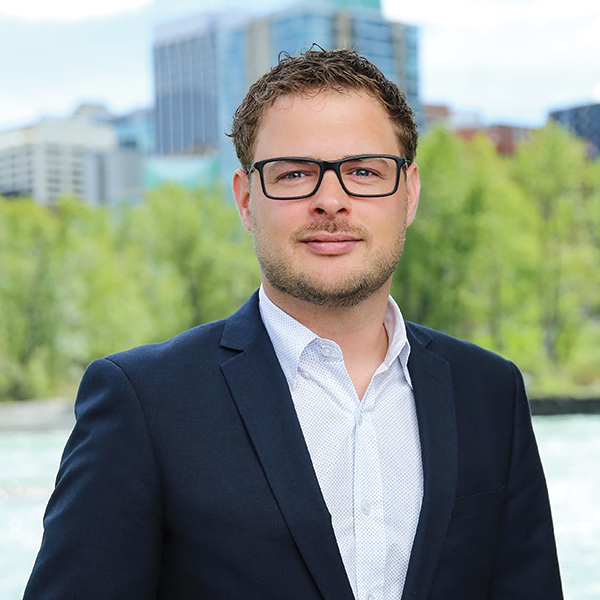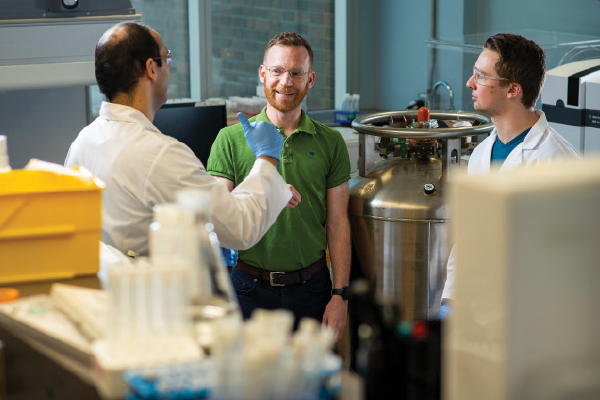"Once we get this project going, we will be able to definitively claim that we are producing the greenest lithium on the planet," says geology grad Chris Doornbos ('05 BSc) from his Calgary office.
Doornbos, president and CEO of E3 Metals, is determined to drive a shift in energy's future, powered by a high-efficiency battery.
"Fundamentally, I've always believed that the key to energy's future is going to be a high-efficiency battery that's going to allow us to move electricity efficiently," explains Doornbos. "This belief originated during my days at university, and it was renewed based on the advancement in the lithium ion battery Tesla uses to power their line of electric vehicles. When you look at the price spike in 2015, lithium as a commodity went from $7,000 a tonne to more than $12,000."
Though Doornbos is quick to point out that lithium batteries aren't the silver bullet to society's environmental challenges, he believes it's a promising start to transition us toward a decentralized energy future.
Doornbos has had what he describes as a varied sort of career, one that-since graduating from the University of Alberta with a geology degree in 2005-has taken him from copper and gold exploration in the Yukon, northern B.C., and Australia, to oil and gas work with industry in Alberta, then back to Australia and subsequently Sweden for another stint in mineral exploration.
In Australia, Doornbos embraced his entrepreneurial leanings and co-founded a company called MinQuest. Working on two projects in Canada motivated an eventual return to his roots, where he found himself itching to start another company, this time on home turf.
"I was told by a mentor that if you can't find the right job, sometimes you have to create it."
And so, that's just what Doornbos did. During his quest for the projects needed to start a new company, there was one mineral Doornbos was most keen to find that often eluded the tenacious entrepreneur: Lithium.
Looking for lithium took the geology grad around the world and back again to Alberta, proving that sometimes what you seek is right before your eyes.
"We looked everywhere for a good lithium project. We'd been in South America, Australia, and Nevada. We even looked at hard-rock projects in Quebec and elsewhere. I was talking to a geologist friend here in Calgary, and he pointed out something I knew but hadn't ever evaluated-that lithium is prolific throughout the Leduc Reservoir. This wasn't new information by any stretch. But we staked some ground that had never been staked before by anyone in Alberta."
Thus, E3 Metals was born.
Doornbos subsequently secured exploration permits for metallic and industrial minerals for more than half-a-million hectares in Alberta (the Leduc Reservoir stretches from southern Calgary to northern Alberta). He simultaneously hustled to both solidify financial support and determine feasibility of the lithium-focused project, the latter bringing him full circle to the University of Alberta.
Collaborative research drives development
Returning to his alma mater, Doornbos connected with Dan Alessi, assistant professor in the Department of Earth and Atmospheric Sciences. The two quickly set to work on a collaborative research development project, supported by NSERC, to determine how best to extract and purify the lithium.
"Collaborative research is a great way to start," says Doornbos. "And we have been really well supported by the federal government. Eventually the work needs to move away from the university so that we can speed up commercialization. So we are taking the dirty boring work out to commercial labs to allow Dan and his team to focus on the fun research and development, testing different ideas."
Alessi and his lab are focusing on developing the chemical side of the extraction technology and will soon be shifting their attention to purifying processes to ensure the lithium meets the 99.999% pure needs of industry.
The team has aggressive goals. E3 wants to be producing lithium by 2021. To meet that time frame, they will be commercializing the extraction technology created by Alessi's team by the end of this year.
In this push to produce sources for sustainable power, Doornbos remains focused on environmentally conscious development. With a goal of no net new ground disturbance, the company will be sourcing project sites abandoned by previous oil and gas operations to minimize the need for new infrastructure.
Around the world, other lithium projects take place in mines or large solar evaporation ponds that occupy large footprints and take 18 to 24 months to produce the precious mineral. E3's process time will be hours and occupy a much smaller footprint to lead to the production of the greenest lithium on the planet.
"Our role is simply to develop greener technologies to get the lithium out of the brine," says Alessi, who holds the Encana Chair in Water Resource Sciences. "We are developing a technology that does not require us to evaporate the brine during the extraction process, and by keeping the lithium in solution, it mitigates the environmental footprint at the surface. And it's essentially turning a waste product into a resource."
For his part, Alessi is happy to be involved in a project that not only provides interesting research questions to answer, provides funding for post-doctoral fellows and graduate students, but also provides sustainable solutions for some of society's most pressing energy needs.
"Lithium is used everywhere now from cellphones to electric cars to aircraft. The demand is only increasing, and there's arguably a world-class lithium resource in the brine located here in the Leduc Reservoir," says Alessi.

